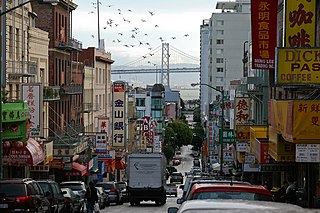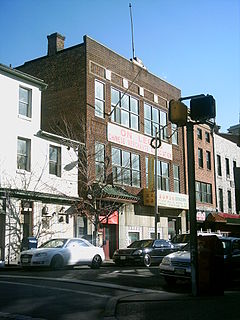About the painting

Painting style
Painted on seven masonite panels with egg tempera and casein, One Hundred Years: History of the Chinese in America stands at an impressive 5 by 17.5 ft (1.5 by 5.3 m). Leong used bold and vibrant colors on the mural and employed curves in order to provide a fluid transition from panel to panel. The symbolism in the mural also helps create flow and connectivity. The mountains, which represent the hope and promise of a new land, connect the first three panels, while the brick walls, which signify exclusion, link the last four panels together. Whether standing or kneeling, all the figures in the mural are active.
Themes and symbolism
The first panel depicts two rice paddy workers and a farmer carrying water, while the Great Wall of China stands in the background. Leong portrays these Cantonese workers, with broad noses and high cheekbones, bending over in order to accomplish their backbreaking labor. The imagery of the Great Wall represents the home country and origins of the Chinese people. The majestic dragon that snakes along the top of the first panel is representative of China—powerful, magical and eternal. This symbol of strength and longevity watches over the Cantonese workers, who struggle yet persevere throughout famine, flood and foreign conquerors. [2]
In the second panel, a Chinese man clad in a blue outfit points to the promise of America and the Gold Mountain. He leaves his wife and child behind. The red square of communism is looming in the background of the somber family.
The third panel depicts a man toiling on the Transcontinental Railroad while another man mines for gold. Here, the Chinese man has finally reached the Gold Mountain, located in the grassy hills of California. The railroad worker stands swinging a pickaxe. The clear display of his queue running down his back shows off his Chinese-ness and devotion to the emperor in China. Like his counterpart in the second panel, the railroad worker wears blue pants, but unlike the former’s thick cotton, the railroad man opts for America’s sturdy blue denim. A hybrid of long pigtails and blue jeans, this worker represents the transitioning of the Chinese in America. [2]
In the fourth panel, a woman in green is sitting and picking fish with her baby slung in a pouch around her back. Another woman in red stands beside her and is drying fish. This panel represents the coming of Chinese women to America. Some came as wives. Some were given false hopes of a better life and working conditions, but upon arrival were forced into domestic servitude or prostitution. These women were indentured for many years before they could pay off their passage over. One woman wears a jade green outfit for prosperity, while the other wears red for good fortune. The baby sits in a blue sling, the same denim blue as the railroad laborer. Rust red brick walls, encasing the women in this panel, depicts the exclusion, as well as protection, of Chinese men. Although the Chinese women go on to settle and create families, they do so within the confines of these red brick walls. [2]
The fifth panel shows a Chinese person dancing the traditional lion dance. The large lion’s head is proudly gleaming towards the audience in a burst of blues, pinks, and whites. With the celebration of Chinese New Year, the lion dance represents prosperity and the arrival of new jobs and new lives. [2]
A Chinese American soldier marches on in the sixth panel. A more somber panel than the former five panels in terms of color and character, this panel portrays the soldier staring downcast with a rifle slung around his back and an assortment of ribbons held in suspension to his left as he returns from World War II. When World War II first began, Chinese Americans enlisted in the Armed Services. The ribbons, which represent the Chinese American’s service in the Armed Forces, hang honorably in front of a white background and portray his success in fighting for a previously all-white America. The soldier walks and steps on paper names, symbolizing the American law of 1962 that allowed for Chinese Americans to remain as American citizens. The brick wall imagery from the fourth panel returns as the soldier marches past the restrictive wall that previously posed as an obstacle. [2]
Leong depicts an assimilated Chinese American family in the seventh and final panel–the father in suit and tie, the mother in traditional Chinese cheongsam, and the young boy in T-shirt and blue denim. The son happily clutches a baseball and mitt. The housing commission wanted the last panel to conclude with a Hollywood happy ending, and Leong succeeded in doing just that. Leong models the family after classic Hollywood cinema stars: the mother as Greer Garson and the father as a composite of Billy Batson and Captain Marvel. The young boy, on the other hand, was modeled after Russell Leong, who has gone on to serve as a professor of English and Asian American studies at the University of California, Los Angeles. This family fusion of Chinese and America stands on a brick pathway as the grand structure of Ping Yuen is set in the background. The brick, once representative of struggle and confinement, now is laid as the pathway to the future of the Chinese American family. Ping Yuen served as a steppingstone and symbol of hope for new Chinese immigrants to America. The housing structures’ bold blue pagoda roofs and red colonnades smile over the Chinese American family, while the golden sun provides a burst of warmth for the family’s happy ending. [2]















